
The Dandelion home geothermal system includes:
The cost of Dandelion’s geothermal heating and cooling systems are comparable with traditional HVAC systems. However, the major benefits of geothermal is not having to relay on purchasing expensive heating fuels, and dealing with deliveries. More information on pricing can be found here, but please remember that each system is custom designed to each home’s needs. To get a personal estimate, take our 30 second survey.
See the Dandelion Heat Pump’s technical specifications for more detail.
Dandelion homeowners have a hard time picking one favorite benefit of having a Dandelion home geothermal system. Below are some direct quotes from homeowners sharing what they love most about their Dandelion system:
SAVINGS
COMFORT
CONVENIENCE
INDEPENDENCE
SAFETY
AIR QUALITY AND ENVIRONMENT
The system requires a new air filter every six months. Switching out the air filter takes less than two minutes.
The lifespan of the Heat Pump is 20-25 years. The lifespan of the ground loops is 50+ years.
The Dandelion Heat Pump comes in three heating capacities and two sizes:
Our design team will determine the best-fit size for your home using the data they collect.
The first step is to take this brief questionnaire to see if your home qualifies.
The Dandelion Heat Pump two-stage compressor allows the system to achieve even higher levels of efficiency when the home doesn’t require the full force of the system.
The heat pump produces heat at two levels of intensity:
Stage 1 = Partial load
Stage 2 = Full load
The system operates at Stage 2 to bring the home up to the desired temperature. Once the home has been brought to the homeowner’s desired temperature, the system will switch to Stage 1, and continue to run on its partial load setting. This two-stage system allows the home to maintain a steady, even temperature efficiently, in terms of both energy and cost.
A water-to-air heat pump is a heat pump for homes that use forced hot air heating (homes that distribute heat using ductwork and vents). Water-to-air heat pumps, like the Dandelion Heat Pump, can provide both heating and air conditioning.
This type of heat pump does not work for homes that use radiators to distribute heat. Homes that use radiators will typically require a water-to-water heat pump.
Few things are as critical as making sure a home’s heating system works reliably day after day, year after year. The Dandelion Heat Pump’s monitoring system enables top performance, reliability, and savings.
The performance monitoring system:
Read about how geothermal heating and cooling works here.
You can read more about the environmental benefits of installing a Dandelion Geothermal Heating & Cooling System here.
Dandelion Geothermal is rarely compatible with AC-only ductwork because these ducts cannot transfer the volume of air needed to adequately heat your home in the winter. Typically, we need to either modify existing AC-only ductwork to enable greater airflow or add new ductwork to the home, both of which we are capable of doing.
If you are interested in modifying the existing ductwork or adding new ductwork to your home, call us at 833-GEO-4ALL or email us at [email protected]
The Dandelion Heat Pump fits homes with forced hot air heating (homes that distribute heat using ductwork and vents).
Check to see if Dandelion is available in your area.
Dandelion prioritizes new areas based on homeowner demand.
There are a few things homeowners can do to help us prioritize their area:
A home will require one or two ground loops depending on its heating and air conditioning needs. The ground loops are installed vertically by creating a hole approximately 6” in diameter, inserting the loop(s) and then filling in the hole. Because the loops are installed in this way, most yards are large enough to accommodate the ground loops. Dandelion’s team will make a decision based on a number of factors after you’ve completed your 30 second survey.
You will receive an invoice soon after your initial quote is signed, and we appreciate you paying that fee at your earliest convenience.
*Please note that your survey will not be scheduled until Dandelion has received the payment*
The $195 survey fee covers a portion of the cost incurred by Dandelion to survey your home/property and the subsequent geothermal system design.
If we determine that your home is a good fit for a Dandelion system, Dandelion will produce and you will have access to:
Should you decide to proceed with the installation, the $195 survey fee will be credited toward your final contract (NTP) price.
The survey fee is not refundable as it covers only a fraction of the actual cost incurred by Dandelion to conduct the survey and subsequent feasibility analysis.
An average home of 2,500-3,000 sq ft will typically have our surveyor(s) on site for about 4 hours.
Larger homes may require the surveyor to be on site for 8 hours or more, depending on total square footage and the complexity of the existing HVAC system.
You or someone over the age of 18 must be home for the duration of the survey.
The surveyor will need access to and take photos of the front, side and back of the home’s exterior, as well as the exterior landscape. These photos will allow our Design team to properly assess for mobilization of equipment, drilling location, trenching path, and to identify any land- or hard-scape elements that may be impacted by the installation process.
The survey will need access to every room inside the home, including the basement/crawlspace and the attic in order to take photos that will result in a complete, to-scale 3D model of the home’s interior.
The photos along with other home data collected by the surveyor allow our Design team to thoroughly assess the property and home to confirm installation feasibility as well to produce accurate heat load calculations (for system sizing) and determine what, if any, additional modifications may be required to the forced air distribution system, electrical system, building envelope, etc..
The Surveyor will take photos and/or document all but not necessarily limited to the following:
Please note that the Surveyor will mark the proposed drilling location(s) with washable chalk paint to document borehole and trench location.
If regular business hours (9am-5pm EST), please call our Scheduling team at 1-914-809-8909
If outside of regular business hours, please call our general support line at 833-GEO-4ALL
Though your Energy Consultant does not have immediate purview over survey scheduling, you can always reach out to your Energy Consultant for further assistance.
Once the system design work is complete, your Energy Consultant will reach out to schedule a review of your final project plan, scope of work, and final project costs. If you have any questions before your project plan review, please reach out to your Energy Consultant.
Our goal is to offer a reasonably accurate cost estimate and scope of work during the initial consultation. However every home is unique and there are a variety of things we may discover that could impact project costs and/or scope of work, including but not limited to: ductwork modifications, electric panel upgrades, landscape/hardscape preparations, existing equipment/appliance removal or relocation, building envelope improvements, etc..
Our goal is to complete your final design and project plan roughly 2-3 weeks after survey completion. Demand for our product is increasing at a remarkable rate and the design timeline is fluid, based heavily on demand at the time of your survey. Your Energy Consultant will be in touch as soon as the project is ready for your review.
The Manual J heat load calculation is a formula that identifies the HVAC capacity of a building. The purpose of the Manual J is to determine the size of the heat pump(s) required to properly condition your home. There are a host of variable inputs entered into the Man J calculations, including but not limited to: the precise square footage of the home, the year the home was built and the construction standards of the time, location and R-value of insulation throughout the home, size/location/type of all windows & doors, even the relationship of the building to the sun (i.e. solar gain), etc.. With this, we can accurately calculate the home’s heat loss and therefore the peak heating load required to be satisfied by the heat pump(s) on the coldest winter nights. The data gathered from the Manual J will also help us determine the size of the ductwork required for proper air flow, as well as the depth and number of boreholes required for the geothermal ground loops.
Once you’re ready to be installed your account manager will contact you with guidance.
The installation happens in three phases:
PHASE 1: Drilling
We drill the vertical bore holes that are used to install the ground loops.
PHASE 2: Trenching
We dig a trench from the bore hole location to your home to connect the ground loops to your geothermal heating & cooling system.
PHASE 3: Interior Install
Lastly, we will remove your existing furnace and install your heat pump, thermostat, and preheated water tank, and any other agreed upon work. This part of the installation takes place inside your home.
The duration of an installation varies based on the factors specific to the home.
Below are typical time frames for each stage of a Dandelion installation:
Ground loops are ~6 inches in diameter, installed to a depth of approximately 500 feet. The exact length will depend on the needs of the given home.
You will need to be home for the parts of the installation that take place inside the home. This includes the installation of the heat pump. You do not need to be home for the installation of the ground loops.
We have three types of drill rigs that are used depending on the access and geological consideration for your property. While our drill rigs vary in size from one another, they are both equally capable of executing the designed job.
Comacchio GEO 600: Track mounted, tight access rig
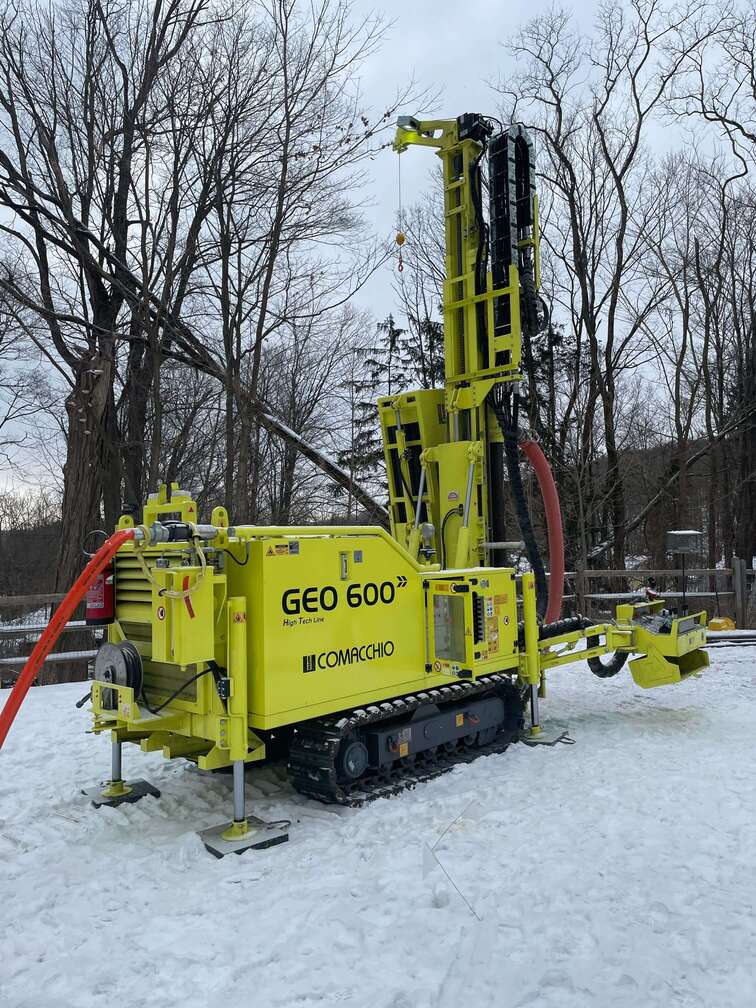
Terrasonic 150 CC: Track mounted, tight access rig
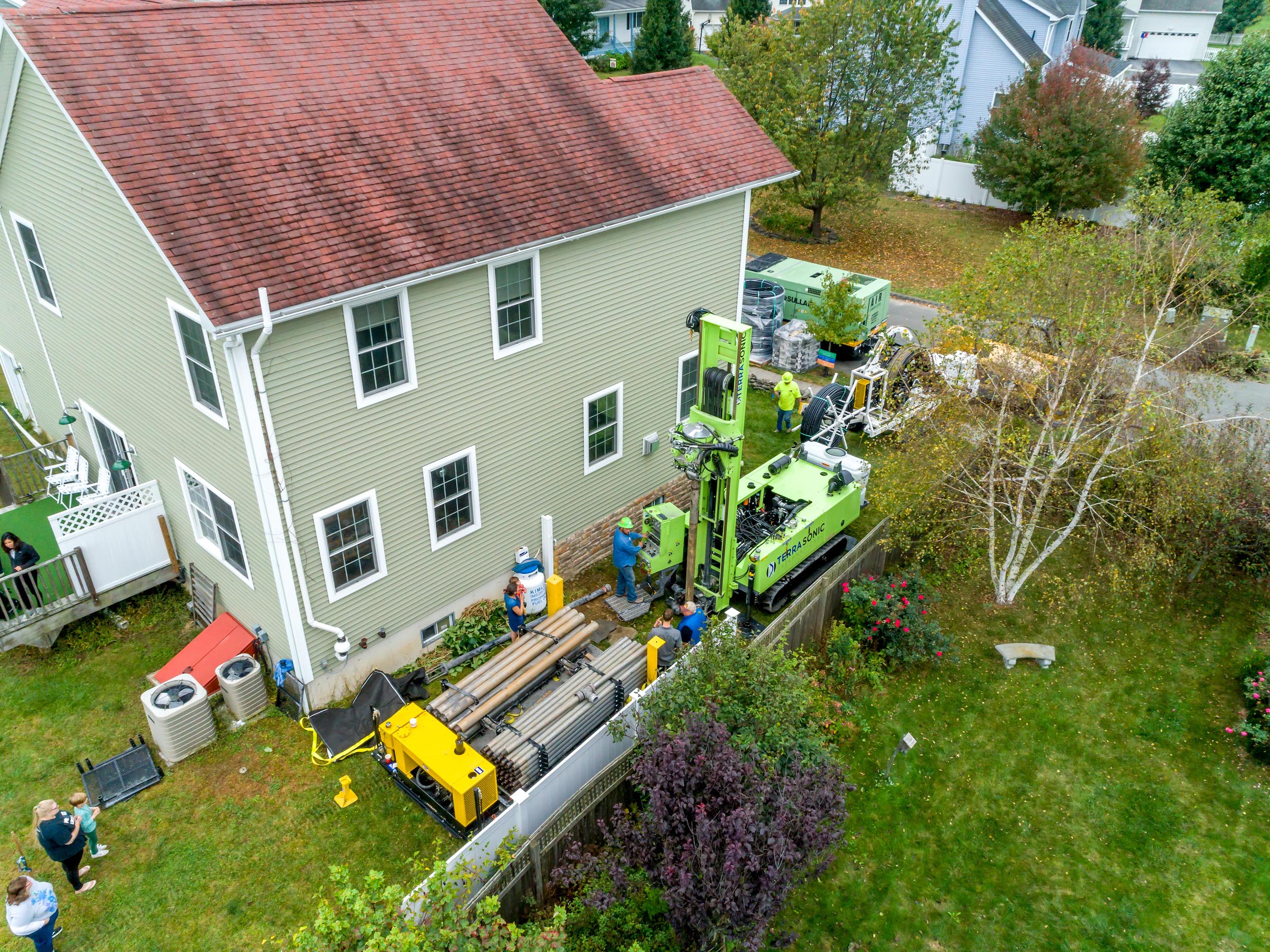
Atlas COPCO TH60: Truck mounted, and larger in size.

Drill rigs are assigned based on access and surface constraints related to your property. A property that is relatively smaller in size is likely to be assigned a tracked rig.
It is important to understand that potential impact to your yard is not just in the location that the boreholes are drilled, but is also related to the amount of water or dust that the geology on your property produces. For example, if your property has a significant aquifer, the act of drilling will draw more water out of the ground, creating more excess water than other properties.
Sediment control:
Dust control:
Dump Trailer:
Drilling location is determined by considering a balance between rig access, trench path, and avoiding utilities so we minimize yard disturbance as much as possible, while still following all the legal requirements necessary to safely work on your property.
Drilling crews typically consist of 2-3 people.
When drilling is complete, you will see the ground loops extend 2-3 ft above ground to let the trenching crew know exactly where the loops are located and where to excavate (these will be cut down). You may have metal casing sticking up until the trenching crew arrives as well. There will also be an overflow of grout, usually grey in consistency and located around the actual borehole. The trenching team is responsible for cleaning up your property and returning it to rough grade.
We use a mini excavator (Bobcat E 32 or E35) that comes on a trailer and is towed by a pick up. We also bring a dump trailer towed by a pick up truck to put drill spoils in.
Trenches are 2ft to 4 ft deep depending on geology and utilities. For trenches above the frostline, the pipes will be insulated.
1-3 people are on a trenching crew. The crew will always consist of 1 crew lead responsible for making sure design is followed.
Our trenching crews will leave your yard in rough grade, meaning they will bring the area back to as close to level as it was previously. We will backfill your trench with soil from your property and do not bring in foreign materials. Soil varies in consistency and color at different depths so the finished product may look different than before work began.
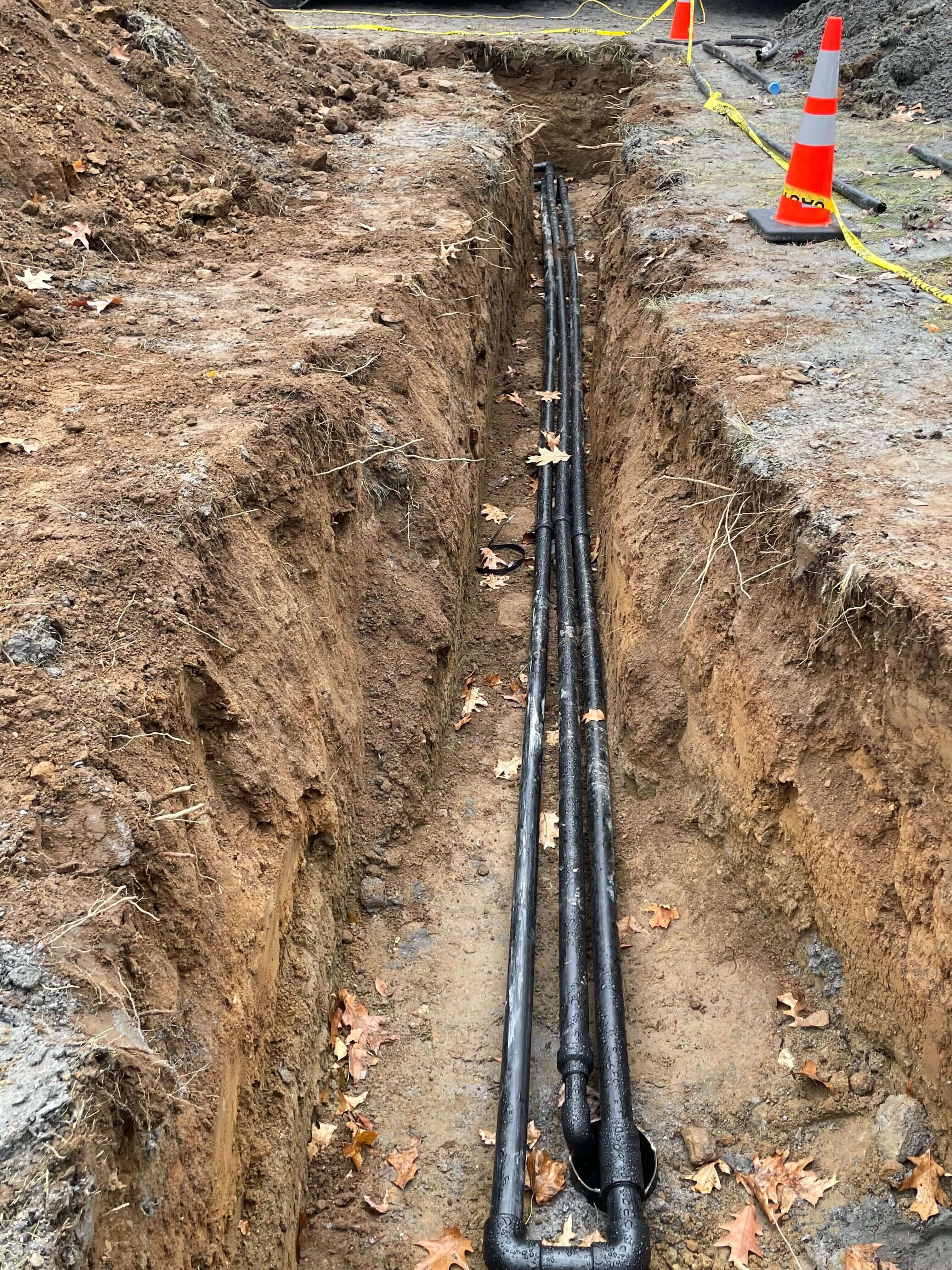

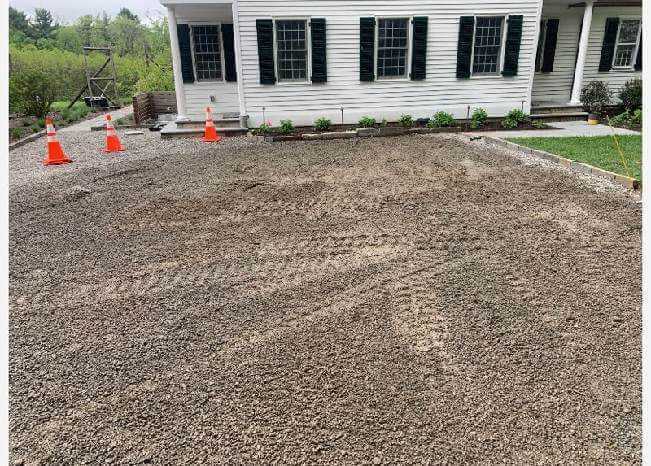
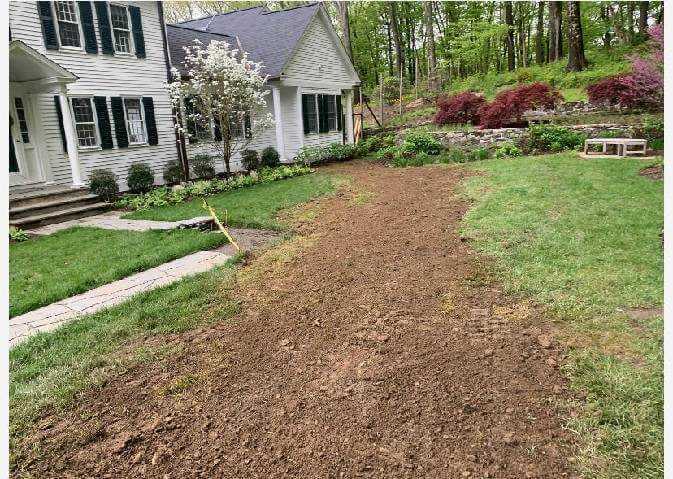
Your equipment will be removed from your property and properly disposed of.
A crew consists of 2-3 people. Depending on the size, scope, and complexity of your project, we may decide to send a larger crew. It is most common for the same crew lead to be onsite for the duration of your project. Personnel availability may lend to swapping out crew members from time to time.
Scope of work will dedicate the length of time associated with your project. Most installs take 2 – 4 days per heat pump. Additional time will be required for additional product options.
You will need to be home for the parts of the installation that take place inside the home. This includes the installation of the heat pump. You do not need to be home for the installation of the ground loops.
It is our goal to never leave you without heating. We are typically able to have at least temporary heat up within the same day of removing your old system. In extenuating circumstances we will provide you with temporary heat which may include space heaters.
We don’t provide additional air conditioning support, but work to get your unit functioning as quickly as possible.
YES! We do replace water heaters in exisiting homes with a heat pump water heater. Unfortunately we do not offer this service for new construction.
Here is a link to the type of water heater being installed: https://www.bradfordwhite.com/professionals/usa-residential-heat-pump/aerotherm-series-heat-pump-re
Electric hot water heaters perform differently than typical fossil fuel water heaters such as natural gas or propane, and we expect that you will experience some performance differences related to how much hot water is available at a given time. While electric hot water heaters are very energy efficient, they are less powerful than typical fossil fuel water heaters. For example, a typical electric heat pump water heater, like the one offered by Dandelion, provides approximately 86 gallons of hot water in the first hour when the tank is full. Once the temperature in the tank starts to decrease, the water heater starts producing hot water again at a maximum rate of 4,500 Watts. Comparatively, a typical 40 gallon gas water heater may provide only approximately 68 gallons of hot water in the first hour when the tank is full. However, the gas water heater is able to regenerate hot water at a rate of 10,500 Watts – 11,500 Watts. Impact to performance and the length of time it takes for your hot water to be replenished varies depending on a variety of factors.
Click on this link for more general information about electrical hot water heaters, including how to determine the appropriate-sized electric hot water heater for your family.
For more information on the cost of a Dandelion Geothermal Heating and Cooling system, please visit this page.
2021 is an exceptionally good year for home geothermal incentives.
More information on federal, state, and utility incentives is available here.